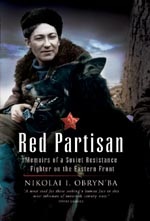Red Partisan: The Memoirs of a Soviet Resistance Fighter on the Eastern Front – Book Review
 Red Partisan: The Memoirs of a Soviet Resistance Fighter on the Eastern Front. Nikolai I. Obryn’ba, author; translated by Vladimir Kupnik. Potomac Books, 2007. 256 pages. 34 photos, 11 drawings. Clothbound. $26.95.
Red Partisan: The Memoirs of a Soviet Resistance Fighter on the Eastern Front. Nikolai I. Obryn’ba, author; translated by Vladimir Kupnik. Potomac Books, 2007. 256 pages. 34 photos, 11 drawings. Clothbound. $26.95.
They were willing to destroy their own buildings and homes.
Many firsthand accounts of World War II are in the form of memoirs. There is a lot of material to be found written by famous officers and politicians of the time. However, what about the lowly soldier? There are some familiar books available, most written by Western Allied soldiers, but in Red Partisan the reader is given a rare look at what life was like on the Eastern Front for a common Russian soldier.
{default}The book is divided into two parts. The first, entitled "Captivity," describes how the author, Nikolai Obryn’ba, and his family first hear rumors of war, and it details his brief time with the Red Army and his prompt capture. We get the impression of a patriotic communist: When the war begins Obryn’ba is exempt from the draft because of his job as a propaganda artist, but he voluntarily gives up his exemption papers to serve his country. The book describes his preparation, departure, and training.
Obryn’ba is quickly captured in the chaos of his first action. The bulk of this section describes the author’s imprisonment by the Germans: the deprivation of captivity; the relationships between prisoners; and the manipulations and bartering to achieve small considerations from his captors. Obryn’ba achieves an elevated status with his captors because of his work as an artist. He is given special treatment, such as when a Major Mentzel ensures that Obryn’ba and his friends are absent when prisoners are selected to work in the Ruhr mines. Mentzel also protects sketches Obryn’ba has made of mass graves outside of camp; he feels it is his duty to help Obryn’ba because he is an artist. Remember that this is a firsthand account. The author is not compiling and editing interviews. He is writing from personal experience.
In the second section, entitled "Red Partisan," Obryn’ba escapes captivity and joins a partisan group in Belorussia. I was surprised to find out that such large groups operated inside German occupied territory. While he is with the partisans Obryn’ba resumes his work as a propagandist, as the chapter title "Savaging the Fascists with Images and Verses" suggests. He also participates in the destruction – and at times brutality – of the partisans. They were willing to destroy their own buildings and homes (one chapter is titled "Granddad, We’re Gonna Burn Your School Down") rather than allow them to be used by the Germans.
They were also willing to punish individuals aiding the Germans. In "Evil Times and Difficult Choices," Obryn’ba tells of the time he was ordered to shoot a polezei (collaborationist police) who wants to join the partisans. The man was assumed to be a traitor and was executed by Obryn’ba. At another time, Obryn’ba must decide what to do when ordered to execute a woman, leaving her children orphaned, because she has a polezei boyfriend. These descriptions are a contrast to the bonds and comradeship written about elsewhere.
The second half of the book may present readers with some challenges. Knowing what we do now, how does the reader feel about the methods used by a dedicated communist during the war? Did the ends justify the means? Were the people who were freed from the Nazis and placed under the control of the USSR any better off? The book doesn’t ask these questions – it is a firsthand account written by a proud Russian communist – but they are questions I asked myself.
Red Partisan is well written and well translated. It’s not a difficult read and includes sixteen pages of photographs and artwork by the author. I enjoyed it as a narrative and for its unique look into the Eastern Front. This memoir is a welcome addition to my bookshelf, and I highly recommend it to anyone interested in learning about what the Eastern Front was like from a partisan’s perspective.

